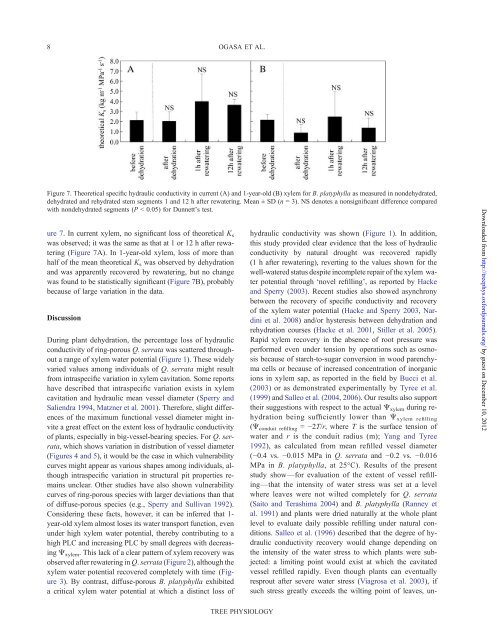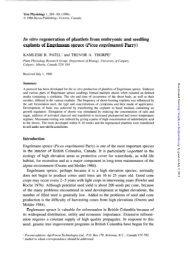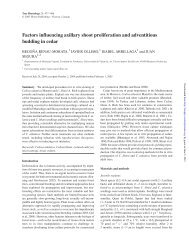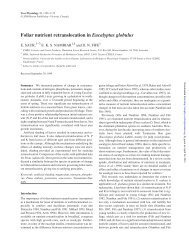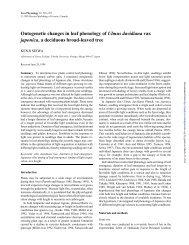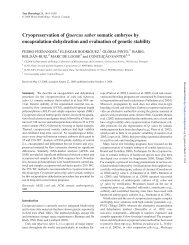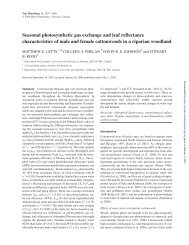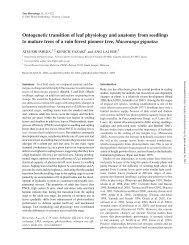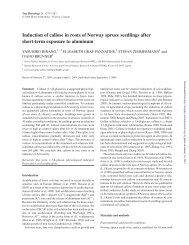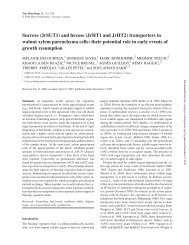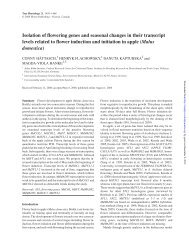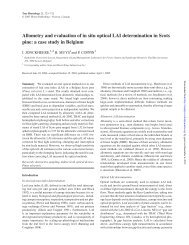Hara: the effect of xylem structures - Tree Physiology
Hara: the effect of xylem structures - Tree Physiology
Hara: the effect of xylem structures - Tree Physiology
You also want an ePaper? Increase the reach of your titles
YUMPU automatically turns print PDFs into web optimized ePapers that Google loves.
8<br />
Figure 7. Theoretical specific hydraulic conductivity in current (A) and 1-year-old (B) <strong>xylem</strong> for B. platyphylla as measured in nondehydrated,<br />
dehydrated and rehydrated stem segments 1 and 12 h after rewatering. Mean ± SD (n = 3). NS denotes a nonsignificant difference compared<br />
with nondehydrated segments (P < 0.05) for Dunnett’s test.<br />
ure 7. In current <strong>xylem</strong>, no significant loss <strong>of</strong> <strong>the</strong>oretical K s<br />
was observed; it was <strong>the</strong> same as that at 1 or 12 h after rewatering<br />
(Figure 7A). In 1-year-old <strong>xylem</strong>, loss <strong>of</strong> more than<br />
half <strong>of</strong> <strong>the</strong> mean <strong>the</strong>oretical K s was observed by dehydration<br />
and was apparently recovered by rewatering, but no change<br />
was found to be statistically significant (Figure 7B), probably<br />
because <strong>of</strong> large variation in <strong>the</strong> data.<br />
Discussion<br />
During plant dehydration, <strong>the</strong> percentage loss <strong>of</strong> hydraulic<br />
conductivity <strong>of</strong> ring-porous Q. serrata was scattered throughout<br />
a range <strong>of</strong> <strong>xylem</strong> water potential (Figure 1). These widely<br />
varied values among individuals <strong>of</strong> Q. serrata might result<br />
from intraspecific variation in <strong>xylem</strong> cavitation. Some reports<br />
have described that intraspecific variation exists in <strong>xylem</strong><br />
cavitation and hydraulic mean vessel diameter (Sperry and<br />
Saliendra 1994, Matzner et al. 2001). Therefore, slight differences<br />
<strong>of</strong> <strong>the</strong> maximum functional vessel diameter might invite<br />
a great <strong>effect</strong> on <strong>the</strong> extent loss <strong>of</strong> hydraulic conductivity<br />
<strong>of</strong> plants, especially in big-vessel-bearing species. For Q. serrata,<br />
which shows variation in distribution <strong>of</strong> vessel diameter<br />
(Figures 4 and 5), it would be <strong>the</strong> case in which vulnerability<br />
curves might appear as various shapes among individuals, although<br />
intraspecific variation in structural pit properties remains<br />
unclear. O<strong>the</strong>r studies have also shown vulnerability<br />
curves <strong>of</strong> ring-porous species with larger deviations than that<br />
<strong>of</strong> diffuse-porous species (e.g., Sperry and Sullivan 1992).<br />
Considering <strong>the</strong>se facts, however, it can be inferred that 1year-old<br />
<strong>xylem</strong> almost loses its water transport function, even<br />
under high <strong>xylem</strong> water potential, <strong>the</strong>reby contributing to a<br />
high PLC and increasing PLC by small degrees with decreasing<br />
Ψ<strong>xylem</strong>. This lack <strong>of</strong> a clear pattern <strong>of</strong> <strong>xylem</strong> recovery was<br />
observed after rewatering in Q. serrata (Figure 2), although <strong>the</strong><br />
<strong>xylem</strong> water potential recovered completely with time (Figure<br />
3). By contrast, diffuse-porous B. platyphylla exhibited<br />
a critical <strong>xylem</strong> water potential at which a distinct loss <strong>of</strong><br />
OGASA ET AL.<br />
TREE PHYSIOLOGY<br />
hydraulic conductivity was shown (Figure 1). In addition,<br />
this study provided clear evidence that <strong>the</strong> loss <strong>of</strong> hydraulic<br />
conductivity by natural drought was recovered rapidly<br />
(1 h after rewatering), reverting to <strong>the</strong> values shown for <strong>the</strong><br />
well-watered status despite incomplete repair <strong>of</strong> <strong>the</strong> <strong>xylem</strong> water<br />
potential through ‘novel refilling’, as reported by Hacke<br />
and Sperry (2003). Recent studies also showed asynchrony<br />
between <strong>the</strong> recovery <strong>of</strong> specific conductivity and recovery<br />
<strong>of</strong> <strong>the</strong> <strong>xylem</strong> water potential (Hacke and Sperry 2003, Nardini<br />
et al. 2008) and/or hysteresis between dehydration and<br />
rehydration courses (Hacke et al. 2001, Stiller et al. 2005).<br />
Rapid <strong>xylem</strong> recovery in <strong>the</strong> absence <strong>of</strong> root pressure was<br />
performed even under tension by operations such as osmosis<br />
because <strong>of</strong> starch-to-sugar conversion in wood parenchyma<br />
cells or because <strong>of</strong> increased concentration <strong>of</strong> inorganic<br />
ions in <strong>xylem</strong> sap, as reported in <strong>the</strong> field by Buccietal.<br />
(2003) or as demonstrated experimentally by Tyree et al.<br />
(1999) and Salleo et al. (2004, 2006). Our results also support<br />
<strong>the</strong>ir suggestions with respect to <strong>the</strong> actual Ψ<strong>xylem</strong> during rehydration<br />
being sufficiently lower than Ψ <strong>xylem</strong> refilling<br />
(Ψ conduit refilling = −2T/r, where T is <strong>the</strong> surface tension <strong>of</strong><br />
water and r is <strong>the</strong> conduit radius (m); Yang and Tyree<br />
1992), as calculated from mean refilled vessel diameter<br />
(−0.4 vs. −0.015 MPa in Q. serrata and −0.2 vs. −0.016<br />
MPa in B. platyphylla, at 25°C). Results <strong>of</strong> <strong>the</strong> present<br />
study show—for evaluation <strong>of</strong> <strong>the</strong> extent <strong>of</strong> vessel refilling—that<br />
<strong>the</strong> intensity <strong>of</strong> water stress was set at a level<br />
where leaves were not wilted completely for Q. serrata<br />
(Saito and Terashima 2004) and B. platyphylla (Ranney et<br />
al. 1991) and plants were dried naturally at <strong>the</strong> whole plant<br />
level to evaluate daily possible refilling under natural conditions.<br />
Salleo et al. (1996) described that <strong>the</strong> degree <strong>of</strong> hydraulic<br />
conductivity recovery would change depending on<br />
<strong>the</strong> intensity <strong>of</strong> <strong>the</strong> water stress to which plants were subjected:<br />
a limiting point would exist at which <strong>the</strong> cavitated<br />
vessel refilled rapidly. Even though plants can eventually<br />
resprout after severe water stress (Viagrosa et al. 2003), if<br />
such stress greatly exceeds <strong>the</strong> wilting point <strong>of</strong> leaves, un-<br />
Downloaded from<br />
http://treephys.oxfordjournals.org/ by guest on December 10, 2012


